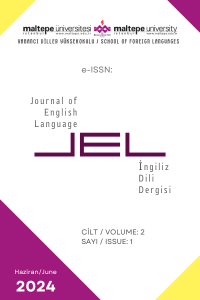Sınıf Duvarlarını Dolaylı Öğrenme Materyali Olarak Kullanmanın İkinci Dil Öğrenenlerin Öğrenmesine Etkisi
Abstract
Bu nicel çalışmada, sınıf duvarlarını dolaylı materyal olarak kullanmanın ikinci dil öğrenenlerin öğrenmesi üzerindeki etkisini araştırıldı. Araştırmanın katılımcı grubunu araştırmacının öğretmeni olduğu 22 ilkokul öğrencisi oluşturmuştur. Katılımcılara daha önce derste öğrenmedikleri hedef konu hakkında ön test uygulanmış ve sonuçları raporlanmıştır. Hedef konuyla ilgili materyaller sınıfın duvarına asılmıştır. Bu malzemeler 3 günde bir değiştirilmiştir. Bu dönemde derste bu konuyla ilgili hiçbir şey işlenmemiştir. 30 günün sonunda aynı test öğrencilere son test olarak uygulanmış ve sonuçlar raporlanmıştır. Ön ve son test sonuçları karşılaştırılmıştır. Öğrencilerin son testteki başarı oranları daha yüksektir. Dolaylı öğretim yöntemi olarak sınıf duvarlarının kullanılmasının öğrencilerin hedef konuyu öğrenmelerine olumlu etkisi olduğu sonucuna varılmıştır.
References
- Carter, R. (2003). Language awareness. ELT Journal. 57(1). 64-65.
- Dickinson, L. (1993) Talking shop: aspects of autonomous learning. In ELT Journal. 47(4), 331-335.
- Garita, C. O. & Sanchez, V. B. (2021) Indirect learning strategies in university students’ efl development. Mextesol Journal. 45(1). 1-18.
- Goertzen, M. J. (2017). Introduction to quantitative research and data. Library technology reports, 53(4), 12-18.
- Naeimi, M & Foo, T. C. V. (2015). Vocabulary acquisition through direct and indirect learning strategies. English language teaching. 8(10).
- Noddings, N. (2003). Is teaching a practice? Journal of Philosophy of Education. 37(2). 241-251. https://doi.org/10.1111/1467-9752.00323
- Nurwanda, Y. (2019). The use of indirect learning strategies for assisting students’ writing skill in expository and argumentative writing class. Retain. 7(2). 78-87
- O’Grady, W. & Chu, S. W. (2011) Language acquisition: the emergence of a grammar. Academia. 326-362
- Ortiz, J. Z. P. (2006) Evaluating students’ autonomous learning through their uses of a self-access centre. Research Articles. 54-73.
- Oxford, R. L., & Scarcella, R. C. (1994). Second language vocabulary learning among adults: state of the art in vocabulary instruction. System, 22(2), 231–243. https://doi.org/10.1016/0346-251x(94)90059-0
- Saffran, J. R., Senghas, A. & Trueswell, J. C. The acquisition of language by children. From the Academy. 98(23). 12874–12875. https://doi.org/10.1073/pnas.231498898
- Schowalter, A. (2021, Sempember 16) Direct learning definition. How to discuss. https://howtodiscuss.com/t/direct-learning-definition/86596
- Taghinezhad, A. & Azizi, M. & Shahmohammadi, S. & Kashanifar, F. S. & Azadikhah, M. (2016) Comparing the effects of direct and indirect learning strategies on Iranian efl learners’ vocabulary learning. Journal of Applied Linguistics and Language Research. 3(1). 133-143.
- Washburne, J. N. (1936). The definition of learning. Journal of Educational Psychology, 27(8), 603–611. https://doi.org/10.1037/h0060154
- Yoon, H. & Jo, J. W. (2014) Direct and indirect access to corpora: an exploratory case study comparing students’ error correction and learning strategy use in l2 writing. Language Learning & Technology. (18)1. 96-117.
The Impacts of Using Classroom Walls as Indirect Learning Materials on Second Language Learners' Learning
Abstract
This quantitative study explored the effect of using classroom walls as indirect material on the learning of L2 learners. 22 Turkish primary school students formed the participant group for the study. Participants were given a pre-test about the target topic, which they had never learned in the course before, and the results were reported. Materials related to target topic were hanged on the classroom wall. These materials were changed every 3 days. During this period, nothing related to this subject was covered in the course. At the end of 30 days, the same test was applied to the students as a post-test again and the results were given. The results of these two tests were compared. Students performed more correct answers on the post-test. It was concluded that using classroom walls as indirect teaching method has a positive effect on students' learning the target subject.
References
- Carter, R. (2003). Language awareness. ELT Journal. 57(1). 64-65.
- Dickinson, L. (1993) Talking shop: aspects of autonomous learning. In ELT Journal. 47(4), 331-335.
- Garita, C. O. & Sanchez, V. B. (2021) Indirect learning strategies in university students’ efl development. Mextesol Journal. 45(1). 1-18.
- Goertzen, M. J. (2017). Introduction to quantitative research and data. Library technology reports, 53(4), 12-18.
- Naeimi, M & Foo, T. C. V. (2015). Vocabulary acquisition through direct and indirect learning strategies. English language teaching. 8(10).
- Noddings, N. (2003). Is teaching a practice? Journal of Philosophy of Education. 37(2). 241-251. https://doi.org/10.1111/1467-9752.00323
- Nurwanda, Y. (2019). The use of indirect learning strategies for assisting students’ writing skill in expository and argumentative writing class. Retain. 7(2). 78-87
- O’Grady, W. & Chu, S. W. (2011) Language acquisition: the emergence of a grammar. Academia. 326-362
- Ortiz, J. Z. P. (2006) Evaluating students’ autonomous learning through their uses of a self-access centre. Research Articles. 54-73.
- Oxford, R. L., & Scarcella, R. C. (1994). Second language vocabulary learning among adults: state of the art in vocabulary instruction. System, 22(2), 231–243. https://doi.org/10.1016/0346-251x(94)90059-0
- Saffran, J. R., Senghas, A. & Trueswell, J. C. The acquisition of language by children. From the Academy. 98(23). 12874–12875. https://doi.org/10.1073/pnas.231498898
- Schowalter, A. (2021, Sempember 16) Direct learning definition. How to discuss. https://howtodiscuss.com/t/direct-learning-definition/86596
- Taghinezhad, A. & Azizi, M. & Shahmohammadi, S. & Kashanifar, F. S. & Azadikhah, M. (2016) Comparing the effects of direct and indirect learning strategies on Iranian efl learners’ vocabulary learning. Journal of Applied Linguistics and Language Research. 3(1). 133-143.
- Washburne, J. N. (1936). The definition of learning. Journal of Educational Psychology, 27(8), 603–611. https://doi.org/10.1037/h0060154
- Yoon, H. & Jo, J. W. (2014) Direct and indirect access to corpora: an exploratory case study comparing students’ error correction and learning strategy use in l2 writing. Language Learning & Technology. (18)1. 96-117.
Details
| Primary Language | English |
|---|---|
| Subjects | English As A Second Language |
| Journal Section | Research Articles |
| Authors | |
| Early Pub Date | May 26, 2024 |
| Publication Date | May 31, 2024 |
| Submission Date | May 1, 2024 |
| Acceptance Date | May 23, 2024 |
| Published in Issue | Year 2024 Volume: 2 Issue: 1 |

